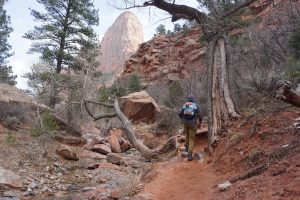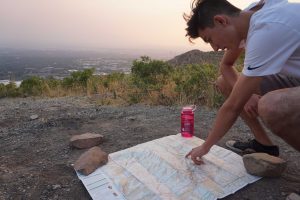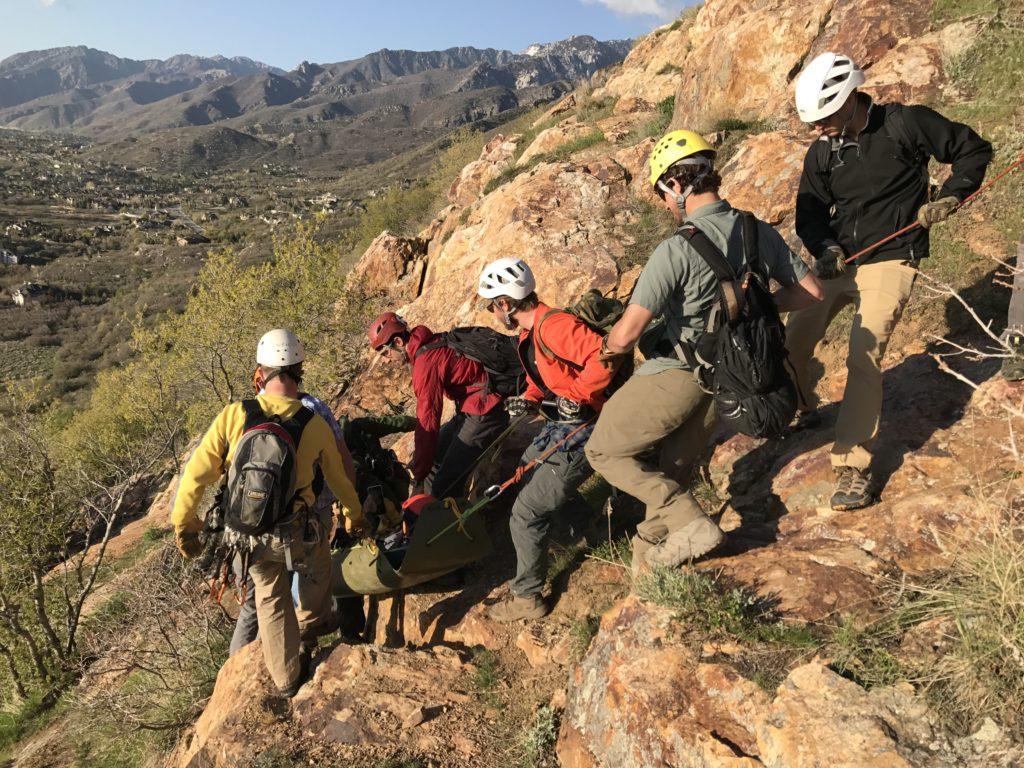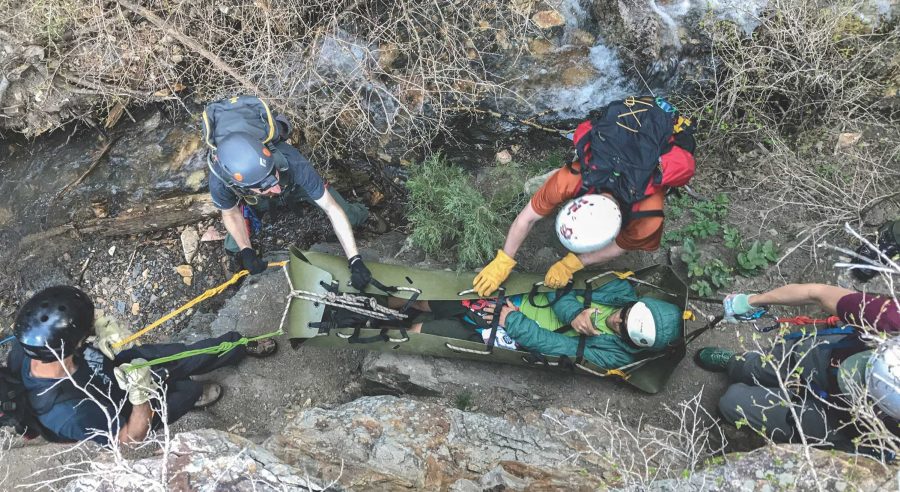On the early morning of July 15th, 1993, a group of eight started the approach towards Kolob canyon in Zion National Park. The third biggest canyoneering route in the park, Kolob is famous for having water flow through its tight walls year round thanks to regular releases from Kolob Reservoir just up the road. The group, consisting of three adults and five youth, had only minor experience in the technical aspects of canyoneering. Nonetheless, they were able to find maps, route descriptions, and general information on how to descend the canyon (known as “beta”) through published guidebooks.
 A small flow, 5 cubic feet per second (cfs) or lower, through the canyon makes it enjoyable, but much more than this and it becomes dangerous. Once pleasant waterfalls turn into torrents that pummel and disorient rappellers, and clear, mellow swims become bubbling baths of whitewater and hydraulics. Unfortunately, the group of eight arrived at the top of Kolob to find it in the latter conditions. Flows that day were estimated to be at 29 cfs, or six times higher than the recommended limit. Five days later, one adult and five youth were pulled out of the canyon by search and rescue (SAR). Two of the leaders had died in trying to get the group out of the dangerous conditions on the first day.
A small flow, 5 cubic feet per second (cfs) or lower, through the canyon makes it enjoyable, but much more than this and it becomes dangerous. Once pleasant waterfalls turn into torrents that pummel and disorient rappellers, and clear, mellow swims become bubbling baths of whitewater and hydraulics. Unfortunately, the group of eight arrived at the top of Kolob to find it in the latter conditions. Flows that day were estimated to be at 29 cfs, or six times higher than the recommended limit. Five days later, one adult and five youth were pulled out of the canyon by search and rescue (SAR). Two of the leaders had died in trying to get the group out of the dangerous conditions on the first day.
Stories like this are not uncommon in outdoor recreation. A group, unprepared in gear, skills, or experience, finds a fun adventure online and plans a weekend to tackle it. Right now, a google search will yield many results for Kolob Canyon. Full betas, GPS tracks, and trip reports are readily available for anyone with an internet connection to download. Zion National Park will issue a permit to any group who has called the Washington County Water Conservancy District to check the release rate from Kolob Reservoir and is willing to pay the fee. All the information to get you from your car to the bottom of the first rappel, a point after which there is no turning around, exists for free online.
The outdoor world has been struck by the same technological tidal wave that has flooded

nearly every other industry in America. While more efficient gear, more convenient navigation, and increased access to information allow recreationalists better opportunities to get outside, cases like the Kolob tragedy raise the question as to whether or not the change is for the better.
Does technology make us safer?
“Well that’s a double edge sword,” states Richard Ingebretsen, medical director of Salt Lake County search and rescue and founder of Wilderness Medicine of Utah. Sometimes, technology is very helpful. Products like the Garmin inReach, which offer the magical ability to send texts, SOS messages, and track your location on a map from anywhere in the world, have helped Ingebretsen and the SAR team reach lost outdoor goers quickly and have saved lives.
In June 2010, for example, Abby Sunderland’s life was saved by a Personal Locator Beacon designed by NASA. She was months into her attempt to become the youngest person to sail unassisted around the world when a storm crippled her boat. Stranded 2,000 miles off the west coast of Australia, Sunderland was able to signal for help using her beacon. Minutes later, her signal was received, and just under an hour later, her location was pinpointed. The nearest vessel, a French fishing boat, was directed to her location. She was saved only two days after she sent the distress call.
Satellites and personal location technology provide a secure backup, and, if everything goes well like it did for Sunderland, could turn ‘search and rescue’ into just ‘rescue.’ However, as Ingebretsen explains, rarely do things go right. “Sometimes, even if you can spot them, you still can’t get to them.” Not every rescue is done in open water, where visibility is unaffected. Slot canyons, dense brush, alpine forests, and expansive deserts all make accessing troubled adventurers even more difficult. In these cases, sending out a distress call does little to help, as the issue isn’t finding the victim, but reaching them.
What’s more troubling is the way in which people misuse beacons and personal locators. Often, the recreationalist isn’t in any real peril, but feels scared or uncomfortable, and so signals for SAR to come to help them. “It’s a game of crying wolf,” Ingebretsen says. “[The beacon pushers] need a toothbrush, or they’ll need a band-aid… so search and rescue teams are responding to minor things because they can call them.” Unlike the fable, search and rescue will not stop responding to cries of wolf, they are obligated to respond to every distress call, but the unnecessary calls waste time, and, more importantly, resources. Joe Dougherty with Utah Emergency Management told Good 4 Utah that about $270,000 is paid out each year to cover the cost of search and rescue operations.
Worse than that, Ingebretsen believes, is how technology, “makes people feel safer when maybe they’re not.” Having a GPS unit which can send a distress call grants the holder a sense of safety. If things really turn south, helicopters, trained EMTs, and a warm cup of cocoa are seemingly just the push of a button away. This encourages people to push past what they’re capable of or equipped to do, getting them into situations which they might have avoided otherwise. Gear is also folly to this. “Case in point is helmets. About 14-15 mph and they provide no great relief, but people think they do so they ski faster.” Avalanche beacons, helmets, life jackets and all other items of safety equipment are meant to protect a user if something bad happens to occur. They are not created to allow users to act recklessly without fear of injury, but that is how they are often treated.
Melding Maps and Monitors
Like any tool, technology in the outdoors can be used properly, and improperly. In 2013, two men running Westwater Canyon, a section of the Colorado River near the Utah-Colorado border, got lost hiking back to their cars. They set a GPS waypoint where their car was parked, and traveled across the near featureless slickrock desert until late evening, following the device. By the time nightfall came, their GPS was dead, and they were lost. Fortunately, the duo had knowledge of the area and knew that they’d hit a road if they headed east. They followed the rising sun the next morning, found a road, and were able to get back to their cars unharmed. When technology failed the pair, they fell back upon their skills to self-rescue.
Adam Crenshaw, a 20 year veteran of the United States Army and avid canyoneer, says those skills are something all recreationalists should have. While training in the army, Crenshaw learned, “a very raw form of orienteering.” Often he was barred from using a compass so he relied on the sun, stars, and different terrain features. On easier days, he was allowed to make his own compass. All this left him with a navigation skillset far superior to anything most recreationalists can hope to achieve, yet when Crenshaw goes out canyoneering he brings a GPS.
“It’s a tool to find more experiences and more adventure out there.” When coupled with his traditional navigation skills, Crenshaw finds a more enjoyable experience. He uses his GPS as his, “quick reference,” while actually in the canyon, but prior to leaving he plots his route on a real map, using a pencil and protractor. This before work familiarizes Adam with the map and the area. “If the GPS were to go out then I already have the map all set to use.” This difference can be critical, especially in the flat desert, where locating yourself on a map can be incredibly difficult. If combined correctly though, “technology can be an enabler.”
Melding technology and real skills yield rewards past navigation. Climbing, mountain biking, canyoneering, trail running, backpacking, rafting and a myriad of other sports have been touched by the innovative hand of technology. However, no amount of carbon fiber can replace the intuition and decision making of its user. Accidents happen: ropes get coreshot at the top of 300’ rappels, bike tires pop in the middle of the wilderness, and plenty of remote trails fade into walls of brush. Gadgets make life easier when everything goes right, but knowing how to respond in situations where everything goes wrong is the true hallmark of an adventurer.



